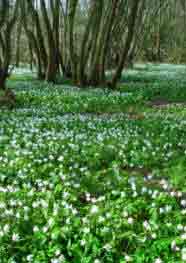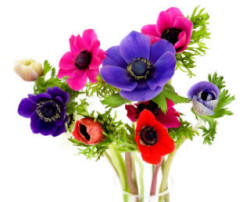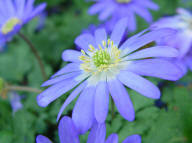There are a wide range of Anemones in this Genus - from the Buttercup family of Ranunculaceae. Here we are interested only in those that are produced from tubers or those anemones that have rhizomatous roots.
The late flowering perennial Japanese Anemones, have neither tubers or rhizomes, and are fibrous rooted herbaceous perennials, so are not included in this section.
The Anemones that are produced from tubers or rhizomes, are normally spring and summer flowering types - as against the Japanese Anemones which flower well into the autumn.
This superb woodland drift of Anemone sylvestris - the Snowdrop Anemone - was photographed in early spring. before the foliage of the Cobnuts appeared.
 The
main growing conditions favoured by Anemone sylvestris, is
light shade or sun - provided by the managed woodland, well drained but
humus rich soil - provided by the annual leaf fall of the overhead
trees.
The
main growing conditions favoured by Anemone sylvestris, is
light shade or sun - provided by the managed woodland, well drained but
humus rich soil - provided by the annual leaf fall of the overhead
trees.
Not many of us will have the advantage of such natural conditions, so we either have to adapt our garden to suite the various types of Anemones, or better still, grow those Anemones which are suited to our own particular garden.
Some Anemones, such as the colourful Anemone coronaria 'De Caen' and 'St Brigid' group, will grow in most any soil conditions - and are specially suited to containers. These are normally planted in the early spring, and will soon start into growth, giving flowers in early summer.

The 'De Caen' group of Anemones are well suited to growing as cut flower - as can be seen in the image, and are often sold in florists shops in mixed or single colour bunches. Anemone de caen bulbs or tubers as they really are, can be bought in mixed bags from most garden centres in autumn or spring.
Both group make a stunning display in window boxes and other containers, with their brightly coloured flowers and attractive cut leaf foliage. They are normally obtainable in garden centres in early spring - sometimes in Autumn - but should be planted early spring. Delay planting of Anemone de caen bulbs until spring.

The ever-popular Anemone blanda - available in various blue and pink
shades together with white.
Planting and Growing Anemones from Tubers.
For specific planting, growing conditions, please refer to the List of Anemone Varieties.
Other than the De Caen and St Brigid Anemones, all other tuberous
Anemones are best planted in the autumn. This gives them plenty of time
to get established in their positions before breaking into growth and
then flower in the following spring or early summer.
If bad weather conditions do not allow for this, then the tubers can be
individually planted in small pots - and overwintered before planting
out in the spring. Soak the tubers in water for twenty-four hours before
planting. It is not always easy to see which is top and bottom of the
knobbly tubers. A little hint! - If in doubt, then plant them on their
side. It works.
Most of the Anemone tubers are best planted with around 2in deep. In areas where squirrels are regular visitors, protect with wire netting or similar until the spring.
After planting your Anemone de caen bulbs, there is little to do other than await your display. For the first few years in permanent plantings of Anemones, nothing to do other than dress the soil with bonemeal in the spring. After three to four years, it will be possible to dig up the Anemones in the dormant season - summer is best, after the foliage has died completely down - and carefully divide the groups of tubers you now have!
Pests and Diseases of Anemones
Tuberous Anemones are relatively trouble-free. However, along with their fibrous rooted Japanese cousins, the are susceptible to slug and snail damage in early spring/summer. A little leaf spot and powdery mildew are also a disease that might be encountered. Best to treat the emerging foliage with a general fungicide spray - three times in the spring at two week intervals.
Propagation of Anemone Tubers
As mentioned above, naturalised tuberous Anemones can be divided when mature - in the Summer. Rhizome types that are autumn flowering, can be divided in spring.
Seed is possible - but a long wait before seedling emerge, and a very erratic germination can mean that full germination can take several months - even a year! Sow the seed in seed trays and leave in cold frame until germinated. Thereafter a wait of a few years before they get to flowering size. Buying tubers is best!
List of Anemone Types and flowering periods